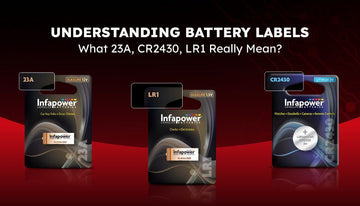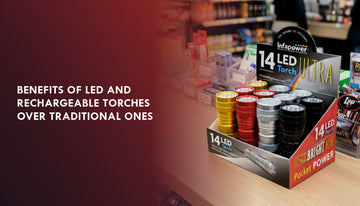Batteries power countless devices in our daily lives, from remote controls to smoke alarms. Yet, the cryptic codes on their labels—23A, CR2430, LR1—can leave many puzzled. These designations are more than random letters and numbers; they provide critical information about a battery’s size, chemistry, and intended use. In this blog, we’ll demystify these labels, helping you choose the right battery for your devices with confidence. Whether you’re replacing a battery in a key fob or a torch, understanding these codes ensures compatibility and optimal performance.
Why Battery Labels Matter?
Battery labels are a universal language, guiding consumers and manufacturers alike. They indicate a battery’s physical dimensions, chemical composition, and voltage, ensuring you select a compatible power source. Using the wrong battery can damage devices, reduce performance, or even pose safety risks. In the UK, where a variety of battery types are available in shops and online, decoding these labels is essential for making informed choices.
The Anatomy of a Battery Label
Battery labels typically consist of letters and numbers, each part revealing specific details. The letters often denote the battery’s chemistry or shape, while numbers indicate size or voltage. For example, a label like CR2430 breaks down into components that describe its type (CR for lithium coin cell), diameter (24 mm), and thickness (3.0 mm). Understanding this structure helps you navigate the vast array of batteries available.
Common Battery Types and Their Codes
Batteries come in various shapes and chemistries, each suited to specific applications. Below, we explore some common types and their labels, focusing on 23A, CR2430, and LR1, alongside other frequently encountered designations.
Alkaline Batteries: LR1 and Beyond
Alkaline batteries are widely used in household devices like torches, toys, and clocks. The LR1, also known as an N-size battery, is a small cylindrical battery measuring about 30.2 mm in height and 12 mm in diameter. The “L” indicates alkaline chemistry, while “R1” refers to its round shape and size. LR1 batteries deliver 1.5 volts and are ideal for low-drain devices requiring steady power.
Other alkaline batteries, such as AA (LR6) or AAA (LR03), follow similar naming conventions. The “R” stands for round, and the number denotes a specific size standard set by the International Electrotechnical Commission (IEC). Alkaline batteries are cost-effective and reliable for everyday use, but are not rechargeable.
Lithium Coin Cells: Decoding CR2430
Lithium coin cells, like the CR2430, are flat, disc-shaped batteries commonly found in watches, calculators, and medical devices. The “C” signifies lithium chemistry, “R” indicates a round shape, and “2430” breaks down to a 24 mm diameter and 3.0 mm thickness. These batteries provide 3 volts and are prized for their long shelf life and stable performance in low-drain applications.
CR2430 batteries are part of a broader family of coin cells, including CR2032 and CR2025, where the numbers reflect different sizes. Their compact design makes them perfect for devices where space is limited, but they must be handled carefully due to their small size, which poses a choking hazard for children.
Specialty Batteries: The 23A Explained
The 23A battery, often called A23, is a slim, cylindrical battery used in remote controls, garage door openers, and key fobs. Measuring approximately 28.5 mm in length and 10.3 mm in diameter, it delivers 12 volts, making it suitable for devices requiring higher voltage in a compact form. The “23” in its label refers to its size, while “A” distinguishes it as a specialty alkaline battery.
Unlike standard AA or AAA batteries, 23A batteries are less common and often sold in single packs. Their high voltage and small size make them ideal for niche applications, but they are not interchangeable with other types due to their unique dimensions and power output.
Battery Chemistry: What the Letters Mean
The letters on battery labels reveal their chemical makeup, which affects performance, lifespan, and suitability for specific devices. Here’s a breakdown of common chemistries:
-
L (Alkaline): Found in LR1 and similar batteries, alkaline chemistry offers a balance of cost and performance. These batteries are non-rechargeable and excel in moderate-drain devices.
-
C (Lithium): Used in CR2430 and other coin cells, lithium batteries provide high energy density and long shelf life, ideal for low-drain, long-term use.
-
S (Silver Oxide): Common in watch batteries like SR44, silver oxide offers a stable voltage for precision devices.
-
Z (Zinc-Air): Used in hearing aid batteries, zinc-air batteries activate when exposed to air, providing high energy in a compact form.
Each chemistry has trade-offs. For instance, lithium batteries last longer but are pricier, while alkaline batteries are cheaper but less suited to high-drain devices like digital cameras.
Choosing the Right Battery
Selecting the correct battery involves matching the label to your device’s requirements. Check the device manual or the old battery for the exact code, such as 23A or CR2430. If the manual isn’t available, note the battery’s shape, size, and voltage, then compare it to standard types. Most UK retailers, from supermarkets to electronics shops, stock these batteries, but online platforms often offer bulk deals.
Voltage and Compatibility
Voltage is critical. A CR2430 (3V) won’t work in a device expecting an LR1 (1.5V), and a 23A (12V) is too powerful for most low-voltage devices. Always match the voltage to avoid damaging electronics. Size also matters; even if voltages align, a battery that doesn’t fit the compartment won’t work.
Rechargeable vs. Non-Rechargeable
Most batteries with labels like 23A, CR2430, or LR1 are non-rechargeable due to their chemistry. For rechargeable options, look for NiMH (Nickel-Metal Hydride) batteries in standard sizes like AA or AAA. Rechargeables reduce waste but may not suit devices requiring specific voltages or sizes, such as coin cells.
Safety and Disposal Tips
Batteries require careful handling and disposal to protect both users and the environment. Swallowing small batteries like CR2430 can be life-threatening, so store them out of reach of children. If a battery leaks, avoid skin contact and clean the device with a damp cloth.
In the UK, battery recycling is widely available. Retailers, supermarkets, and local councils offer collection points for used batteries. Never bin batteries, as they contain chemicals that can harm the environment. Recycling ensures materials like lithium and alkaline compounds are safely recovered.
Common Misconceptions About Battery Labels
Battery labels can spark confusion. Some believe all batteries with similar sizes are interchangeable, but a CR2430 and a CR2032, despite looking alike, differ in thickness and capacity. Another myth is that higher voltage always means better performance; in reality, devices are designed for specific voltages, and exceeding them can cause damage.
Navigating UK Standards
In the UK, battery labels adhere to IEC standards, ensuring consistency across brands. However, some devices may use older or proprietary codes, so cross-referencing with modern equivalents (e.g., LR1 for N-size) is helpful. Always check the packaging for additional details, such as shelf life or recommended uses.
Practical Applications in Everyday Life
Understanding battery labels empowers you to maintain your devices efficiently. A 23A keeps your car key fob operational, while a CR2430 ensures your fitness tracker runs smoothly. LR1 batteries power smoke alarms, providing peace of mind. By decoding these labels, you avoid trial-and-error purchases and extend the life of your electronics.
Where to Buy in the UK
Batteries like 23A, CR2430, and LR1 are readily available at UK retailers, including high-street chains, hardware stores, and online marketplaces. For specialty batteries like 23A, check electronics shops or order online for convenience. Always buy from reputable sources to avoid counterfeit or expired batteries.
Final Thoughts
Battery labels like 23A, CR2430, and LR1 are more than cryptic codes—they’re a roadmap to choosing the right power source for your devices. By understanding their meaning, you can make informed decisions, ensuring compatibility and performance. Whether you’re powering a remote control or a medical device, decoding these labels saves time, money, and hassle. Next time you’re at a UK shop or browsing online, you’ll know exactly what to pick.







